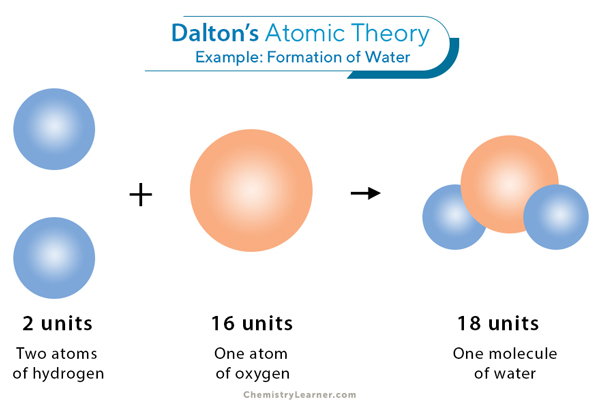Dalton’s Atomic Theory
Table of Contents
In 1804, English chemist and physicist John Dalton introduced an atomic model to understand the composition of matter. According to this theory, all compounds are made of indivisible particles, known as atoms, that combine in well-defined ratios. However, his theory was only in words. No experiment existed at that time to prove it [1-4].
Postulates of Dalton’s Atomic Theory
Dalton made a few assumptions in his atomic theory [1-4].
1. All matter is composed of atoms that are indivisible.
The laws of conservation of mass and definite proportions can be explained using the concept of atoms. Dalton proposed that all matter is made of tiny indivisible atoms, which he imagined as “solid and movable particles”.
2. All atoms of a given element are identical in mass and properties.
Dalton proposed that every single atom of a specific element is the same as that of every other element. Elements may share similar properties like boiling and melting points and electronegativity. However, no two elements can have the same set of properties. For example, an oxygen atom is different from a carbon atom.
3. Compounds are formed from the combinations of two or more different types of atoms.
Dalton proposed that compounds comprise two or more atoms of different types. For example, household common salt comprises two elements with varying physical and chemical properties. One is sodium (Na), which is a highly reactive metal. The other is chlorine (Cl), which is a gas. When they react, the Na and Cl atoms combine in a 1:1 ratio to form white crystals of sodium chloride (NaCl).
4. A chemical reaction is a rearrangement of atoms.
Dalton suggested that chemical reactions neither destroy nor create atoms. They just rearranged the atoms. In the above example, sodium and chlorine combine to make salt. However, both the sodium and chlorine atoms still exist. They rearrange to form a new compound.
Limitations
While Dalton’s atomic theory laid the path toward the fundamental understanding of atoms and matter, it had a few demerits [4].
1. Does not account for subatomic particles
Dalton stated that atoms are indivisible and cannot be further divided. However, we know an atom consists of electron, proton, and neutron.
2. Does not account for isotopes
Dalton states that atoms of a given element have precisely the same masses. However, it was later established that atoms of the same element can have different masses. They are known as isotopes. For example, hydrogen, deuterium, and tritium are isotopes with different masses.
3. Does not account for isobars
Dalton states that atoms of different elements can have different masses. However, it was found that even atoms of different elements can have the same mass. These atoms are called isobars. For example, argon and calcium have an atomic mass of approximately 40 amu.
4. Does not account for allotropes
Dalton’s theory could not explain the different allotropes of the same element. For example, it cannot explain the differences in the properties of the two carbon allotropes – diamond and graphite.






3 Responses to Dalton’s Atomic Theory